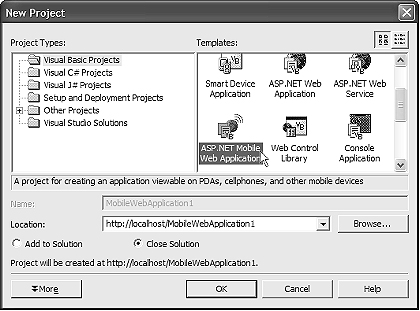Using the Simulator
| Team Fly |
Page 645
connection between client browser and server (or database) was not necessary. This decoupling of the remote user from the server is also a feature that distinguishes the CF from other mobile-computing platform initiatives, such as WAP (Wireless Application Protocol, a UNIX-derived standard for Internet communications and telephony on pagers, PDAs, two-way radios, cell phones, and other wireless devices). With the CF, you, the programmer, can balance the advantages, and the mix, of server-side versus client-side code execution. Also, one doesn't foresee the CF attempting to service pagers or two-way radios. Their I/O limitations are just too severe.
Security is also superior on the CF because it's managed code, and it has access to the various Code Access Security strategies described in Chapter 5.
When you program for the CF you benefit from many of the familiar and useful tools in the justly praised .NET IDE. You can also write your code in VB.NET or C# (the two languages currently supported in the CF). On the minus side, because the CF is a subset of the full .NET Framework, many tools and many language features are available to you, but some are not. If you've ever programmed with VBScript or other script versions of languages, you understand that limitations are built in.
The single most significant advantage of using the .NET CF, however, is that you can leverage your knowledge of how to write VB.NET programs, and how to use the .NET IDE tools, when programming for mobile devices. Most of the familiar features and techniques—ADO.NET, ASP.NET, security classes, and so on—are right there at your disposal, ready to be applied to the new and sometimes challenging task of creating mobile applications.
Using the Simulator
Within VB.NET 2003 is a facility for designing and testing CF applications. It roughly simulates the user experience of running your application, similar to the way that ASP.NET applications can be previewed in the Internet Explorer browser during development by pressing F5 to execute them. This simulation is a way for you to test the functionality of your application, but it cannot replicate how your application will actually look on mobile devices. In fact, it will look different on different devices. In any case, you can get the I/O sketched in, and the logic working and tested. Then you can switch to emulation, or actual testing on target devices for any final tweaking.
Try it out. Choose File New
New Project then double-click the ASP.NET Mobile Web Application icon in the New Project dialog box, as shown in Figure 22.1:
Project then double-click the ASP.NET Mobile Web Application icon in the New Project dialog box, as shown in Figure 22.1:

FIGURE 22.1 This icon is your gateway to building and modeling a PDA or cell phone application.
| Team Fly |
EAN: 2147483647
Pages: 178